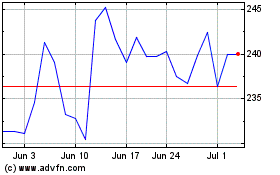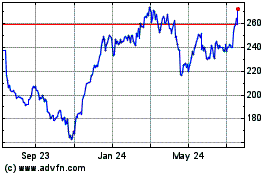Hot Housing Market Drives Overall Consumer Debt Higher Ahead of New Mortgage Stress Test
June 08 2021 - 5:00AM

While most consumers are ratcheting back on their credit card debt,
homebuyers have pushed new mortgage volumes to unprecedented levels
according to Equifax Canada’s most recent report on consumer credit
conditions. New mortgages are up 41.2 per cent in Q1 compared to Q1
2020 and the average limit on new mortgages grew by 20.5 per cent
to $326,930.
Overall consumer debt now stands at $2.08 trillion, up 0.62 per
cent from last quarter and up 4.78 per cent from Q1 2020. Much of
the new mortgage growth adding to the overall debt was driven by
B.C. and Ontario, which saw jumps of 59.2 per cent and 44.3 per
cent in volume respectively compared to Q1 2020.
“Low interest rates and speculation around U.S. inflation
impacting our interest rates has fueled mortgage volumes as
consumers fear future interest rate hikes,” said Rebecca Oakes, AVP
of Advanced Analytics at Equifax Canada. “Competition among
homebuyers is fierce in many markets across the country. We’ll
monitor whether the new mortgage stress test helps to cool off the
hot housing market.”
The Office of the Superintendent of Financial Institutions
(OSFI) introduced new mortgage stress test criteria in June to set
the qualifying rate on uninsured mortgages at a contracted rate
plus two percentage points or 5.25 per cent, whichever is higher,
which will limit the purchasing capacity of a lot of buyers and
might help slow down the overheated mortgage market.
Credit card debt plummets to a new low, reaching 2015
levels
Despite the increased activity in the housing market, most
Canadians are living more frugally as credit card debt has
continuously declined since the pandemic began. Credit card debt is
now at its lowest level in six years as consumers are paying off
debts more than they are spending. On average, credit card balances
dropped by 9.9 per cent in Q1 of this year compared to last year
and by 4.2 per cent compared to the last quarter of 2020.
“Lower interest rates, multiple lockdowns and higher
unemployment rates have led to changes in consumer behaviour, which
has slowed overall credit card growth during the pandemic,” said
Oakes. “While deferral programs have come to an end for most
consumers, government incentives are still in place, which has
helped consumers in paying down their credit card debt.”
The number of cards per consumer has been on a downward
trajectory since 2016. Consumers are moving away from multiple
cards and being more careful with their credit. Younger consumers
who are more likely to miss payments on credit cards have also seen
a drop in their spend-to-payment ratio. Likewise, Gen Z has managed
to reverse this ratio and are also paying off their credit card
debt.
The average consumer debt (excluding mortgages) dropped again
this quarter to $20,430, which is a year-over-year decrease of 4.2
per cent from Q1 2020.
Delinquencies continue to decline
Non-mortgage delinquencies saw a year-over-year decline of 21.8
per cent and a quarter-over-quarter decline of 4.0 per cent with
credit cards and non-bank auto loans showing the biggest drop.
The 90+ day mortgage delinquency rate dropped by 19.0 per cent
compared to Q1 2020 and by 7.4 per cent versus Q4 2020. Mortgage
delinquency rates are at an all-time low, but there are some
variations across cities and provinces. Most provinces and cities
have shown a decline in mortgage delinquencies except for Vancouver
and Fort McMurray. Vancouver showed a 14.6 per cent increase in the
90+ day mortgage delinquency rate compared to Q1 2020, while Fort
McMurray showed the biggest spike with a 38.0 per cent increase
compared to the previous year.
“The road to recovery continues to be uneven with non-mortgage
delinquency rates among younger consumers (under 35) on the rise
since last quarter, but older consumers have managed to keep their
non-mortgage delinquencies at lower levels,” added Oakes.
“Successful vaccine rollouts will be the critical factor in opening
up the economy, which will have a big impact on consumer spending
and debt management. Canadians should be preparing themselves for a
point in time, which will likely come in this calendar year, when
governments begin to rein in support mechanisms.”
Debt (excluding mortgages) & Delinquency
Rates
|
Age |
Average Debt (Q1
2021) |
Average Debt
ChangeYear-over-Year(Q1 2021 vs.
Q1 2020) |
Delinquency Rate(Q1 2021) |
Delinquency Rate
ChangeYear-over-Year(Q1 2021 vs.
Q1 2020) |
|
18-25 |
$8,476 |
-0.89 |
% |
1.42 |
% |
-24.29 |
% |
|
26-35 |
$16,369 |
-2.07 |
% |
1.49 |
% |
-21.06 |
% |
|
36-45 |
$24,219 |
-4.53 |
% |
1.18 |
% |
-23.72 |
% |
|
46-55 |
$30,578 |
-4.64 |
% |
0.89 |
% |
-22.15 |
% |
|
56-65 |
$25,875 |
-5.17 |
% |
0.79 |
% |
-20.18 |
% |
|
65+ |
$14,336 |
-4.67 |
% |
0.90 |
% |
-20.69 |
% |
|
Canada |
$20,430 |
-4.25 |
% |
1.04 |
% |
-21.85 |
% |
Major City Analysis – Debt (excluding
mortgages) & Delinquency Rates
|
City |
Average Debt(Q1 2021) |
Average Debt
ChangeYear-over-Year(Q1 2021 vs.
Q1 2020) |
Delinquency Rate(Q1 2021) |
Delinquency Rate
ChangeYear-over-Year(Q1 2021 vs.
Q1 2020) |
|
Calgary |
$25,295 |
-4.24 |
% |
1.31 |
% |
-17.02 |
% |
|
Edmonton |
$24,537 |
-4.24 |
% |
1.54 |
% |
-13.75 |
% |
|
Halifax |
$21,177 |
-4.48 |
% |
1.21 |
% |
-24.46 |
% |
|
Montreal |
$15,236 |
-5.02 |
% |
0.93 |
% |
-32.87 |
% |
|
Ottawa |
$17,970 |
-6.18 |
% |
0.96 |
% |
-18.82 |
% |
|
Toronto |
$19,020 |
-2.87 |
% |
1.26 |
% |
-17.69 |
% |
|
Vancouver |
$21,661 |
-2.95 |
% |
0.78 |
% |
-19.38 |
% |
|
St. John's |
$23,703 |
-2.95 |
% |
1.39 |
% |
-19.12 |
% |
|
Fort McMurray |
$37,757 |
-1.63 |
% |
1.71 |
% |
-17.01 |
% |
Province Analysis - Debt (excluding mortgages)
& Delinquency Rates
|
Province |
Average Debt(Q1 2021) |
Average Debt
ChangeYear-over-Year(Q1 2021 vs.
Q1 2020) |
Delinquency Rate(Q1 2021) |
Delinquency Rate
ChangeYear-over-Year(Q1 2021 vs.
Q1 2020) |
|
Ontario |
$20,295 |
-4.23 |
% |
1.00 |
% |
-19.99 |
% |
|
Quebec |
$17,566 |
-5.33 |
% |
0.71 |
% |
-35.95 |
% |
|
Nova Scotia |
$20,992 |
-3.22 |
% |
1.36 |
% |
-25.19 |
% |
|
New Brunswick |
$22,297 |
-3.66 |
% |
1.48 |
% |
-21.38 |
% |
|
PEI |
$21,826 |
-1.31 |
% |
1.03 |
% |
-17.11 |
% |
|
Newfoundland |
$22,919 |
-1.36 |
% |
1.43 |
% |
-21.22 |
% |
|
Eastern Region |
$21,868 |
-2.83 |
% |
1.39 |
% |
-22.69 |
% |
|
Alberta |
$25,404 |
-4.06 |
% |
1.46 |
% |
-14.02 |
% |
|
Manitoba |
$16,896 |
-4.52 |
% |
1.18 |
% |
-25.36 |
% |
|
Saskatchewan |
$22,677 |
-3.04 |
% |
1.36 |
% |
-19.23 |
% |
|
British Columbia |
$21,119 |
-3.20 |
% |
0.90 |
% |
-19.59 |
% |
|
Western Region |
$22,355 |
-3.68 |
% |
1.19 |
% |
-17.52 |
% |
|
Canada |
$20,430 |
-4.25 |
% |
1.04 |
% |
-21.85 |
% |
* Based on Equifax data for Q1 2021
About EquifaxAt Equifax (NYSE: EFX), we believe
knowledge drives progress. As a global data, analytics, and
technology company, we play an essential role in the global economy
by helping financial institutions, companies, employees, and
government agencies make critical decisions with greater
confidence. Our unique blend of differentiated data, analytics, and
cloud technology drives insights to power decisions to move people
forward. Headquartered in Atlanta and supported by more than 11,000
employees worldwide, Equifax operates or has investments in 25
countries in North America, Central and South America, Europe, and
the Asia Pacific region. For more information,
visit Equifax.ca and follow the company’s news on
LinkedIn.
|
Contact: |
|
|
Andrew Findlater |
Tom Carroll |
|
SELECT Public Relations |
Equifax Canada Media Relations |
|
afindlater@selectpr.ca |
MediaRelationsCanada@equifax.com |
|
(647) 444-1197 |
|
Equifax (NYSE:EFX)
Historical Stock Chart
From Mar 2024 to Apr 2024

Equifax (NYSE:EFX)
Historical Stock Chart
From Apr 2023 to Apr 2024
